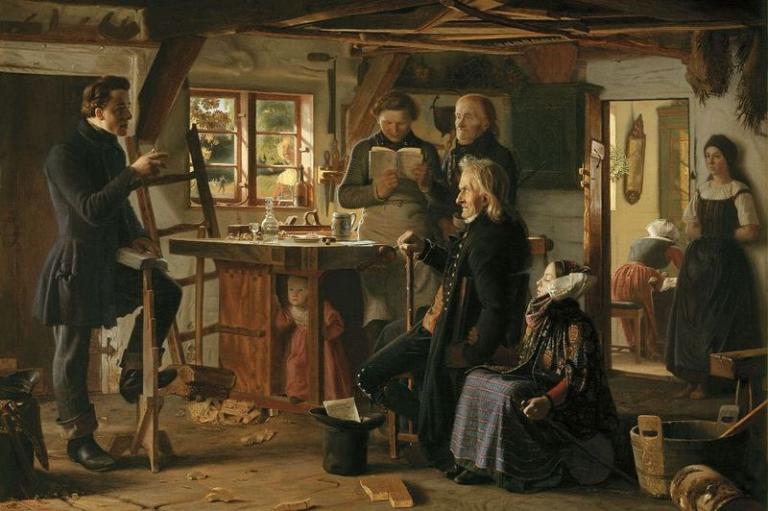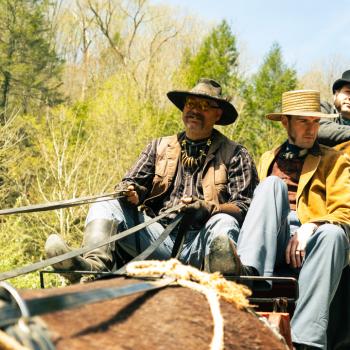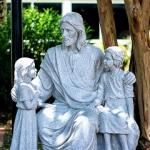
Painted in 1856 by Christen Dalsgaard, this work hangs in the Statens Museum for Kunst, in Copenhagen. (Wikimedia Commons public domain image)
For Christmas, a neighbor gave us a new book by her brother. The book is Gary C. Lawrence, Millions Believe As We Do, But Haven’t Yet Found the Church: Conversation Ideas from a National Poll. Gary Lawrence is an active Latter-day Saint — currently, I believe, an ordinance worker in the Newport Beach California Temple — and a professional public opinion researcher (with a B.A. in political science from Brigham Young University and a Ph.D. in public affairs communication from Stanford University).
I was vocally enthusiastic about his 2008 book
Back in 2020, The Atlantic published one of the better recent journalistic articles about the Church of Jesus Christ of Latter-day Saints: “The Most American Religion: Perpetual outsiders, Mormons spent 200 years assimilating to a certain national ideal—only to find their country in an identity crisis. What will the third century of the faith look like?”
Among other passages, I was struck by this one regarding the hit Broadway musical The Book of Mormon, a passage that strikes me as precisely right:
But then I met a theater critic in New York who had recently seen the musical. He marveled at how the show got away with being so ruthless toward a minority religion without any meaningful backlash. I tried to cast this as a testament to Mormon niceness. But the critic was unconvinced. “No,” he replied. “It’s because your people have absolutely no cultural cachet.”
How to develop “cultural cachet”? This is where a horde of faithful Latter-day Saint composers, playwrights, actors, novelists, artists, and thinkers would come in handy. Plus, we have a really interesting history to tell, with lots of drama. And our demographic center in the Great Basin West features a lot of spectacular terrain that should draw even more interest from tourists than it already does. But I doubt that achieving “cultural cachet” is a realizable goal for us. And we certainly shouldn’t seek it directly, let alone with pathetic and needy desperation. It would be very nice if we were to be more engaged with the wider culture, neither completely disregarded because of our seeming oddness nor having sold out by “aping the Gentiles.” And perhaps that day will come. However, even then our image as nice and polite, but prim, naïve, weird, and intellectually dull — the likable simpletons of The Book of Mormon on Broadway and in London — will almost certainly continue with us, whether or not it’s really deserved.
Our continuing (though much lessened) isolation in Utah and surrounding areas means that relatively few Americans or others get to know us. And, since we don’t dress distinctively (i.e., wearing hijabs or yarmulkes), people elsewhere may well not realize that their dentist, carpenter, pharmacist, delivery man, nurse, attorney, plumber, kindergarten teacher, or accountant is a Latter-day Saint. They’ll only know us as the Other, Out There. Strange, foreign, and exotic while, at the same time, boring, stodgy, uninteresting, and to be avoided if not actually feared. (I regard Gary Lawrence’s How Americans View Mormonism as a really fine treatise on the topic indicated in its title, with some very practical and easy recommendations for Latter-day Saints.)
Here’s a good comment on the Atlantic article that appeared in the Deseret News: “The Atlantic interviewed the prophet. Here’s what it did right”
But back to this new book by Gary Lawrence, Millions Believe As We Do: As its 2008 predecessor did, this book has suggested to my mind various ways of thinking about how to get our message out to those who have not yet heard it, and I wish that everybody interested in building and expanding the Kingdom would read it. (It’s a quick read, but I think I need to return to it and read portions of it very carefully, taking notes on the ideas that come to me as I do so.) I see it as helpful not merely for full-time missionaries — and really, not even very much for them — but especially for ordinary members of the Church who wish that they could do more to help the Church in its mission of taking the Gospel to all the world. Both How Americans View Mormonism and Millions Believe As We Do offer very practical and surprisingly painless methods of steering conversations toward the teachings of the Restoration.
In explaining his thesis, Brother Lawrence cites the official Church missionary manual Preach My Gospel: “The people you meet often do not realize that they are looking for the restored gospel until they have found it.”
This is a crucial point. Gary Lawrence’s contention is that a sizable proportion of Americans already agree with us on certain centrally important issues. They simply don’t realize that they do because, as he showed in his earlier book, despite our nearly two centuries of missionary effort they know remarkably little about us.
Of the doctrinal questions the survey measured, the following three beliefs are especially unique to us in The Church of Jesus Christ of Latter-day Saints. Here are the percentages of non-LDS Christians who agree with us on each as described in the survey questions:
Pre-earthly existence — 24% –We lived with God in heaven before coming to the earth.
Gradations in heaven — 23% — There are different levels in heaven and in hell.
Proxy baptisms for the dead — 22% — Someone else can be baptized on his behalf after he dies.
(105, formatting unavoidably altered)
Given such statistics (and many others), Dr. Lawrence concludes that there are audiences out there that are ready-made for our message, if we can only devise ways of reaching them. I concur, and my thought is that many of the findings in this book would be especially helpful for Latter-day Saint social-media “influencers” and just generally for all missionary-minded Latter-day Saints who are involved, even modestly, on various social media platforms. I myself intend to return to the book and try to think of practical ways in which I can respond to it.













